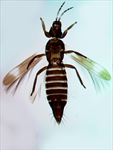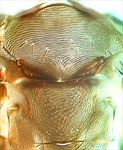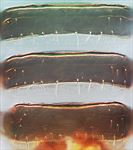Distinguishing features
Female macropterous. Body and legs brown, fore tarsi and apex of fore tibiae paler; antennal segment III yellowish in basal half but darker distally, IV–IX brown; fore wing brown at extreme base including all of clavus, median brown area long, continuous along posterior margin, distal pale area small not transverse, with costal vein dark.
Head with postocular region shorter than eye length; distal maxillary palp segment subdivided. Antennae 9-segmented, III–IV with sensorium extending to basal third of segment, without internal markings. Mesonotum with 2 pairs of accessory setae medially. Metanotal reticles with internal markings variable, linear to dot-like. Abdominal tergite I with transverse lines anteromedially; trichobothria on X no larger than base of major setae on X. Sternites with 4 pairs of marginal setae, V and VI with 1 or 2 pairs of discal setae laterally, VII with 3 pairs laterally but none medially.
Male similar to female but smaller. Abdominal tergite I with two longitudinal ridges. Sternites with 1 or 2 pairs of discal setae laterally, no discal setae on IX.
Related species
The genus Desmothrips is known only from Australia, with 18 described species (Pereyra & Mound, 2010). D. obsoletus is unusual because the postocular region of the head is short. It differs from D. crespii and D. stepheni that also share this character state in having the forewings with distinct dark and light areas.
Biological data
Adult females have been found commonly in the flowers of Acacia pravissima [Fabaceae] at Canberra, but the species is apparently univoltine.
Distribution data
Described on a single specimen from Melbourne, Victoria, and also known from southeastern Queensland, this species is common in Spring around Canberra.
Family name
AEOLOTHRIPIDAE
Species name
Desmothrips obsoletus Bagnall
Original name and synonyms
Desmothrips obsoletus Bagnall, 1924: 626
References
Mound LA (1967) A taxonomic revision of the Australian Aeolothripidae (Thysanoptera). Bulletin of the British Museum (Natural History). Entomology 20: 41–74.
Pereyra V & Mound LA (2010) Phylogenetic relationships within the genus Desmothrips (Thysanoptera, Aeolothripidae), an Australian genus of facultative flower-living predators. Systematic Entomology 35: 306–317.




